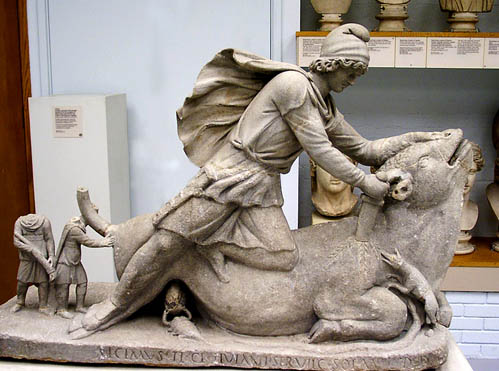Mythraism: A Pagan Religion
Introduction:
Mythraism is an ancient pagan religion that originated in the late Hellenistic period and reached its peak around the 2nd and 3rd centuries A.D. The religion was centered around the worship of the god Mithras, who emerged from the depths of Persian mythology. Mythraism gained popularity throughout the Roman Empire, attracting a wide range of followers, from soldiers to merchants. In this essay, we will explore the origins, rituals, beliefs, and decline of Mythraism.
The Origins of Mythraism:
Mythraism finds its roots in the religious traditions of ancient Persia and ancient Mitanni. Mithras was originally a deity associated with the sun and light in Persian mythology. The cult of Mithras was brought to the Roman Empire by soldiers serving in the eastern provinces, becoming a popular religion among the Roman legionnaires during the late 1st and early 2nd centuries A.D.
The Beliefs of Mythraism:
The belief system of Mythraism was shrouded in secrecy, making it challenging for modern scholars to fully comprehend its doctrines. However, archaeological discoveries and limited written sources provide some insight into its core beliefs. Mythraists believed in the existence of a cosmic struggle between good and evil, with Mithras serving as a guardian against evil forces, symbolized by a bull. The religion placed a strong emphasis on moral purity, self-control, and loyalty to the deity.
Rituals and Practices:
The central ritual in Mythraism was the tauroctony, a depiction of Mithras slaying a bull. This act was considered to be a crucial event symbolizing the victory of good over evil. Mythraic temples, known as mithraeums, were constructed with an underground chamber where the tauroctony scene was portrayed. Initiates would descend into the dimly lit space to partake in the rituals, which often included feasting, purification rites, and communal meals.
Hierarchy and Membership:
Mythraism had a hierarchical structure, with initiates progressing through various levels of membership. The highest rank, known as “pater,” was reserved for the leaders of the cult. Aspiring members had to undergo a series of initiation rituals, which included symbolic tests and moral trials. The initiations aimed to strengthen the individual’s dedication to Mithras and his teachings, reinforcing the community bonds within the cult.
Influence and Diffusion:
Mythraism gained widespread popularity throughout the Roman Empire, particularly within the military and merchant classes. The cult’s appeal lay in its promise of spiritual protection, military success, and salvation. Its teachings, rituals, and imagery spread rapidly, influencing other religions and even entering into syncretism with so-called Christianity. Some argue that certain aspects of Mythraism may have influenced the development of early Christian doctrine and practices.
Decline and Legacy:
Despite its popularity, Mythraism gradually declined during the 4th century A.D. due to several factors such as the rise of Christianity, political instability, and changing religious values. The Roman emperors Constantine and Theodosius increasingly favored so- called Christianity, leading to religious persecutions and the eventual prohibition of pagan practices. As a result, Mythraism, along with other pagan religions, gradually faded into obscurity, leaving behind a legacy that continues to captivate historians and scholars to this day.
Conclusion:
Mythraism offers a unique glimpse into the religious landscape of the ancient Roman Empire. Its origins in Persian mythology, secretive rituals, and moral teachings made Mythraism an intriguing faith. Although the religion eventually succumbed to the growing influence of Christianity and other socio-political factors, its legacy lives on in the fragments of mythological stories, archaeological remains, and the ongoing scholarly exploration of this fascinating pagan religion.
